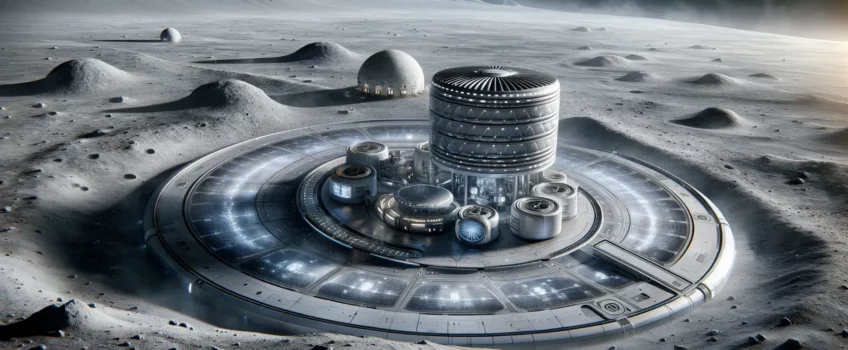
At the forefront of space innovation, Rolls-Royce recently showcased its groundbreaking Micro-Reactor concept at the esteemed UK Space Conference in Belfast. This event marked a significant milestone in the UK Space Agency-backed research initiative, which aims to pioneer the first modular nuclear reactor for lunar exploration. The introduction of this Micro-Reactor model stirred widespread interest across various industries, signifying a new era in space technology.
Major Tim Peake’s Glimpse into Future Space Technology
The conference, a hub for space innovation, was graced by the presence of European Space Agency Astronaut, Major Tim Peake. His visit underscored the importance and potential of the Micro-Reactor. The Novel Nuclear team from Rolls-Royce had the privilege of walking him through the intricacies of this groundbreaking technology, illustrating its vast potential in space applications.
Funding Milestone: A Leap Towards Lunar Power
In a significant advancement this March, Rolls-Royce received a £2.9 million boost from the UK Space Agency. This funding is a testament to the company’s commitment to exploring nuclear power as a viable source for sustaining future Moon bases. The technologies exhibited at the conference are the fruits of this year’s intensive research.
Rolls-Royce’s team of scientists and engineers, in collaboration with strategic partners, have diligently worked on various aspects of the Micro-Reactor. Their focus has been on three key elements: the reactor’s fuel, the heat transfer method, and the conversion of heat into electricity. These efforts are critical in advancing our understanding of these complex systems.
Space missions require a reliable power source, and the Rolls-Royce Micro-Reactor offers a self-sufficient, power-dense solution. Its potential extends beyond providing power for planetary surface habitation and exploration; it also promises to revolutionise spacecraft propulsion and satellite manoeuvrability, thereby safeguarding vital orbits. Additionally, its compact modular design allows for easy transportation and assembly in even the most remote locations.
The Compact Powerhouse: A Unique Micro-Reactor Advantage
The nuclear Micro-Reactor, notable for its small size and light weight, promises uninterrupted power supply under various environmental conditions, including areas with limited sunlight. Rolls-Royce aims to have a reactor ready for lunar deployment by the early 2030s, marking a significant leap in space exploration capabilities.
The Micro-Reactor’s development marks a significant step towards sustainable space exploration. With its potential to provide long-term power solutions, this technology could enable extended human presence on the Moon and facilitate future missions to Mars. Furthermore, nuclear power eliminates the need for constant resupply missions, reducing the cost and environmental impact of space exploration.
Collaborative Excellence: Shaping the Future Together
Rolls-Royce’s journey to this innovative breakthrough has been supported by collaborations with prestigious institutions like the University of Oxford, Bangor University, and others. These partnerships have been instrumental in refining the Micro-Reactor technology, paving the way for its diverse applications in commercial, defence, and space sectors. The company’s commitment to open collaboration and knowledge-sharing aligns with the UK Space Agency’s vision of creating a sustainable space industry for future generations.
The Micro-Reactor concept is a testament to Rolls-Royce’s continued dedication to pushing the boundaries of technology in pursuit of advancing human exploration and enabling a more sustainable future in space. As we continue on this journey, let us remember that our collective efforts and collaborations are essential in shaping a brighter future for space exploration.
Envisioning a Net Zero Future with Micro-Reactor Technology
Abi Clayton, Director of Future Programmes at Rolls-Royce, highlights the significance of the UK Space Agency funding. It has been pivotal in the collaborative research and development of technologies that edge us closer to realizing the Micro-Reactor. This technology is not just a leap for space exploration but also a step towards decarbonizing industries and providing clean, sustainable energy.
Dr Paul Bate, CEO of the UK Space Agency, reiterates the agency’s commitment to supporting space exploration missions and boosting sector growth across the UK. He emphasises the potential of this research in powering continuous human presence on the Moon and enhancing the UK’s space sector.
Recommended: A Significant Breakthrough in Generating Near-Limitless Energy
UK Space Agency’s Moonlight Programme: Lighting the Way to the Moon
The partnership with Rolls-Royce follows the UK Space Agency’s announcement of a £51 million fund for UK companies to develop communication and navigation services for Moon missions. This is part of the European Space Agency’s Moonlight programme, which aims to establish a satellite constellation around the Moon, facilitating communication and navigation for future lunar explorations.
The Rolls-Royce Micro-Reactor, approximately 1 meter in width and 3 meters in length, represents a significant advancement in lunar technology. While currently not capable of producing electricity, it is expected to undergo development over the next six years, with a planned debut space trip in the near future.
The Science Behind the Micro-Reactor: Nuclear Fission
The Micro-Reactor will harness nuclear fission, a process similar to that used in Earth-based nuclear power plants. This differs from the solar energy approach used in most lunar missions, offering a more reliable and continuous power source, especially during the moon’s two-week-long nights. The technology works by splitting uranium atoms, generating heat that is then converted into electricity through a series of thermoelectric devices.
The development of the Micro-Reactor technology promises to revolutionise space exploration and pave the way for sustainable lunar bases. Its potential for powering future missions and decarbonising industries makes it a crucial milestone in our journey towards achieving a net-zero future.
Conclusion
The Rolls-Royce Micro-Reactor represents a significant step forward in nuclear technology and its applications in space exploration. Its compact, power-dense design and potential for long-term power solutions make it a game-changer in the industry. With ongoing collaborations and support from the UK Space Agency, we can envision a brighter future with sustainable space exploration powered by the Micro-Reactor technology.
For more interesting articles covering all the latest in engineering, manufacturing and technology, please follow our blog and join us on social media using the hashtag #PRVtech.


 Mail:
Mail: 



